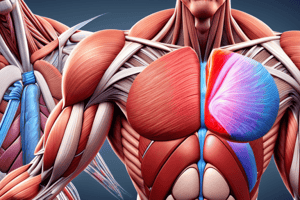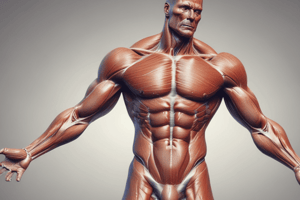Podcast
Questions and Answers
Which type of muscle is described as being voluntary and low endurance?
Which type of muscle is described as being voluntary and low endurance?
- Smooth muscle
- Striated muscle (correct)
- Cardiac muscle
- Involuntary muscle
What is a characteristic feature of cardiac muscle?
What is a characteristic feature of cardiac muscle?
- Hexagonal nuclei
- Intercalated discs (correct)
- Centrally placed nuclei in a hexagonal arrangement
- Voluntary control
Which statement about smooth muscle is accurate?
Which statement about smooth muscle is accurate?
- It is involuntary and has high endurance. (correct)
- It is directly controlled by the nervous system.
- It has multiple nuclei per cell.
- It contains striations.
What does a motor unit consist of?
What does a motor unit consist of?
How does the number of muscle fibres per motor unit relate to dexterity?
How does the number of muscle fibres per motor unit relate to dexterity?
What is the primary function of muscle tissue?
What is the primary function of muscle tissue?
In which part of the body would you primarily find smooth muscle?
In which part of the body would you primarily find smooth muscle?
Which muscle type is responsible for involuntary movements in the organs?
Which muscle type is responsible for involuntary movements in the organs?
Which characteristic is NOT associated with striated muscle?
Which characteristic is NOT associated with striated muscle?
What do the terms 'origin' and 'insertion' refer to in muscle anatomy?
What do the terms 'origin' and 'insertion' refer to in muscle anatomy?
What are hexagonal nuclei a characteristic feature of?
What are hexagonal nuclei a characteristic feature of?
What role do tendons play in the musculoskeletal system?
What role do tendons play in the musculoskeletal system?
How many skeletal muscles are estimated to be present in the human body?
How many skeletal muscles are estimated to be present in the human body?
Which statement best describes the arrangement of muscle fibers?
Which statement best describes the arrangement of muscle fibers?
What type of contraction occurs when a muscle exerts force without changing its length?
What type of contraction occurs when a muscle exerts force without changing its length?
What do myofibrils contain that enables muscle contraction?
What do myofibrils contain that enables muscle contraction?
What is the primary role of a neuromuscular junction (NMJ)?
What is the primary role of a neuromuscular junction (NMJ)?
Which of the following is true about the all-or-nothing response of muscle fibers?
Which of the following is true about the all-or-nothing response of muscle fibers?
In the context of motor units, which muscle has the highest number of fibers per motor unit?
In the context of motor units, which muscle has the highest number of fibers per motor unit?
What type of contraction results in a muscle lengthening while maintaining constant tension?
What type of contraction results in a muscle lengthening while maintaining constant tension?
During which type of isotonic contraction does the muscle shorten?
During which type of isotonic contraction does the muscle shorten?
What is a potential consequence of heavy eccentric loading on muscles?
What is a potential consequence of heavy eccentric loading on muscles?
How does asynchronous firing of motor units benefit muscle contraction?
How does asynchronous firing of motor units benefit muscle contraction?
What is the average number of muscle fibers per motor unit in the human body?
What is the average number of muscle fibers per motor unit in the human body?
What is the duration of the contraction period in muscle physiology?
What is the duration of the contraction period in muscle physiology?
Which phase of muscle contraction occurs immediately after the stimulus?
Which phase of muscle contraction occurs immediately after the stimulus?
What is the consequence of stimulation at a frequency shorter than the twitch time?
What is the consequence of stimulation at a frequency shorter than the twitch time?
How can summation in muscle contraction be achieved?
How can summation in muscle contraction be achieved?
What happens when impulses are sent at a higher frequency of over 40 pulses/sec?
What happens when impulses are sent at a higher frequency of over 40 pulses/sec?
During which period does the muscle not respond to further stimulation?
During which period does the muscle not respond to further stimulation?
In terms of muscle response, what does wave summation entail?
In terms of muscle response, what does wave summation entail?
What is the duration of the relaxation period in the frog's muscle physiology?
What is the duration of the relaxation period in the frog's muscle physiology?
Flashcards
Striated Muscle
Striated Muscle
A type of muscle tissue characterized by visible stripes (striations) under a microscope. It's also known as skeletal muscle because it's typically attached to bones.
Striated Muscle: Voluntary
Striated Muscle: Voluntary
Striated muscles are under conscious control, meaning you consciously decide to move them.
Striated Muscle: Low Endurance
Striated Muscle: Low Endurance
Striated muscles tire more quickly than other muscle types.
Muscle Biopsy
Muscle Biopsy
Signup and view all the flashcards
Cardiac Muscle
Cardiac Muscle
Signup and view all the flashcards
Cardiac Muscle: Involuntary
Cardiac Muscle: Involuntary
Signup and view all the flashcards
Cardiac Muscle: High Endurance
Cardiac Muscle: High Endurance
Signup and view all the flashcards
Smooth Muscle
Smooth Muscle
Signup and view all the flashcards
Smooth Muscle: Involuntary
Smooth Muscle: Involuntary
Signup and view all the flashcards
Smooth Muscle: High Endurance
Smooth Muscle: High Endurance
Signup and view all the flashcards
Motor Unit
Motor Unit
Signup and view all the flashcards
Motor Unit: Variable Fiber Number
Motor Unit: Variable Fiber Number
Signup and view all the flashcards
Skeletal Muscle
Skeletal Muscle
Signup and view all the flashcards
Cardiac Muscle
Cardiac Muscle
Signup and view all the flashcards
Smooth Muscle
Smooth Muscle
Signup and view all the flashcards
Muscle Fiber
Muscle Fiber
Signup and view all the flashcards
Myofibril
Myofibril
Signup and view all the flashcards
Sarcomere
Sarcomere
Signup and view all the flashcards
Tendon
Tendon
Signup and view all the flashcards
Ligament
Ligament
Signup and view all the flashcards
Motor Unit
Motor Unit
Signup and view all the flashcards
Muscle Twitch
Muscle Twitch
Signup and view all the flashcards
Muscle Summation
Muscle Summation
Signup and view all the flashcards
Isometric Contraction
Isometric Contraction
Signup and view all the flashcards
Isotonic Contraction
Isotonic Contraction
Signup and view all the flashcards
Origin
Origin
Signup and view all the flashcards
Insertion
Insertion
Signup and view all the flashcards
Flexor
Flexor
Signup and view all the flashcards
Extensor
Extensor
Signup and view all the flashcards
Motor Unit
Motor Unit
Signup and view all the flashcards
Neuromuscular Junction (NMJ)
Neuromuscular Junction (NMJ)
Signup and view all the flashcards
Motor Unit Fiber Ratio
Motor Unit Fiber Ratio
Signup and view all the flashcards
Isometric Contraction
Isometric Contraction
Signup and view all the flashcards
Isotonic Contraction
Isotonic Contraction
Signup and view all the flashcards
Concentric Contraction
Concentric Contraction
Signup and view all the flashcards
Eccentric Contraction
Eccentric Contraction
Signup and view all the flashcards
All-or-None Response
All-or-None Response
Signup and view all the flashcards
Muscle Fiber Recruitment
Muscle Fiber Recruitment
Signup and view all the flashcards
Frog Gastrocnemius Twitch Duration
Frog Gastrocnemius Twitch Duration
Signup and view all the flashcards
Human Muscle Twitch Duration
Human Muscle Twitch Duration
Signup and view all the flashcards
Muscle Latent Period
Muscle Latent Period
Signup and view all the flashcards
Muscle Contraction Period
Muscle Contraction Period
Signup and view all the flashcards
Muscle Relaxation Period
Muscle Relaxation Period
Signup and view all the flashcards
Refractory Period
Refractory Period
Signup and view all the flashcards
Muscle Summation
Muscle Summation
Signup and view all the flashcards
Multiple Motor Unit Summation
Multiple Motor Unit Summation
Signup and view all the flashcards
Wave Summation
Wave Summation
Signup and view all the flashcards
Muscle Tetanus
Muscle Tetanus
Signup and view all the flashcards
Study Notes
Muscle System Overview
- 40% of the body is skeletal muscle
- There are approximately 650 skeletal muscles
- Over 150 surface (anatomical) muscles
Learning Outcomes
- Discuss the three main muscle types: cardiac, smooth, and striated
- Describe the structure and arrangement of anatomical muscles
- Outline the innervation of the motor unit
- Describe the physiology of whole muscle action including twitch and summation
- Differentiate between isometric and isotonic contraction
Muscle Types
- Skeletal muscle: Attached to bones, voluntary, low endurance
- Cardiac muscle: Walls of the myocardium, involuntary, high endurance
- Smooth muscle: Lines digestive tract, bronchi, and blood vessels, involuntary, high endurance
Striated Muscle
- Also called striped or skeletal muscle
- Voluntary, under direct nervous control
- Low endurance
Muscle Biopsy
- Wide-bore needle inserted into muscle to remove a small sample
- Muscle is analyzed using a microscope and histological stains
Striated Muscle Microscopic Details
- Hexagonal
- Nuclei on the outside (peripheral)
- Fibers are the same size
Cardiac Muscle
- Only in the heart
- Striated, intercalated discs (gap junctions)
- 1-2 nuclei per cell
- Centrally placed
- High endurance
- Innervated by the pace-maker
Smooth Muscle
- 1 centrally placed nucleus per cell
- No striations
- Sustained contraction
Motor Unit
- The functional unit of skeletal muscle (MU)
- Composed of a single motor neuron and the group of muscle fibers innervated by it
- More muscle fibers than motor neurons, some motor neurons innervate more than one fiber
- Fiber number varies with control needed (e.g., larynx 2-3/MU, eye 10/MU, biceps 1000+/MU)
Neuromuscular Junction (NMJ)
- Also known as the motor endplate
- The connection between the muscle fiber and motor neuron
- Membranes of the nerve and muscle cells come into close contact
- One NMJ per fiber
Motor Unit Function
- When a muscle fiber is stimulated at the NMJ, it contracts ("all or nothing" response)
- The degree of contraction of a muscle is determined by the number of stimulated motor units
- Maximal contraction occurs when all motor units are firing together
- In practice, asynchronous firing of motor units results in a graded response for a smooth contraction
Types of Muscle Contraction
- Isometric contraction: Muscle contracts but does not shorten; length is maintained; tension increases
- Isotonic contraction: Muscle changes length; tension remains constant
- Concentric: Muscle shortens
- Eccentric: Muscle lengthens
Concentric Isotonic Contraction
- Force generated by muscle is greater than the load to be lifted
- Muscle shortens in length
Eccentric Isotonic Contraction
- Muscles slow joint movement
- Heavy eccentric loading can damage muscle when overloaded (muscle necrosis)
- Muscles are approximately 10% stronger during eccentric than concentric contractions
Muscle Physiology (Laboratory Preparations)
- Whole muscle function studied using laboratory preparations (e.g., frog gastrocnemius)
- Muscle responds with a 'twitch' (quick contraction) when stimulated electrically
- Twitch duration: 0.1 sec in frogs, 0.05 sec in humans
- Requires specialized equipment for analysis
Phases of Muscle Contraction
- Latent period: Delay between stimulus and visible response
- Contraction period: Muscle shortens
- Relaxation period: Muscle returns to resting length
- Refractory period: Brief period after stimulation when muscle can't respond further
Twitch Summation
- Muscle can respond to a second stimulus while still contracting
- Second stimulus superimposed on first, resulting in greater shortening (summation)
Types of Summation
- Multiple motor unit summation (recruitment): Increased motor unit involvement
- Wave summation: Increasing rate of contraction
Tetanus
- High frequency stimulation fuses successive contractions into a sustained maximal contraction (tetanus)
- Further increased stimulation will not shorten muscle more
References
- Solomon et al, Ch 40
- Alberts et al, Ch 17, pp 599-604
Studying That Suits You
Use AI to generate personalized quizzes and flashcards to suit your learning preferences.




